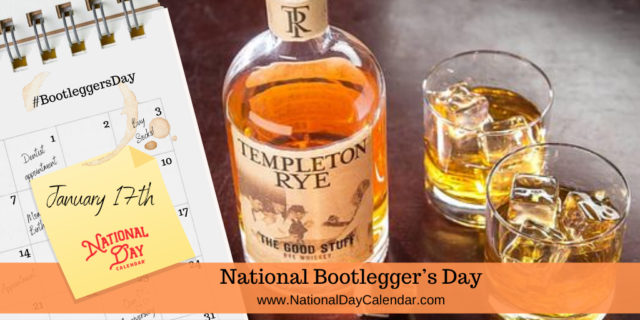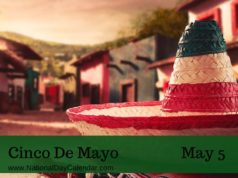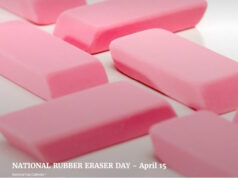
National Bootlegger’s Day is observed annually on January 17.
- January 17 is not only the birthday of Templeton Rye, but it’s also the birthday of Al Capone as well as the original Bootlegger’s son, Meryl Kerkhoff. Please join our community of enthusiasts at the Bootlegger’s Society.
- The earliest use of the term bootlegger was during the 1880s in the Midwest when one would conceal flasks of liquor in their boot tops when going to trade with Native Americans.
- The term found its permanent place in the American vocabulary when Congress passed the Eighteenth Amendment prohibiting the manufacture, transportation, and sale of alcohol in 1920.
- Bootleggers helped fill the demand by smuggling various brews from Canada and Mexico, and later distilling their own liquor in backwoods and secluded areas. They brought their loot back to sell to speakeasies, individuals and other establishments.
- Bootlegging has a legendary history. The Mafia arose out of the illegal and coordinated activities of bootlegging. Storied names like Al Capone, Lucky Luciano, Alphonse Kerkhoff, and Bugs Moran are surrounded by glamour, danger, and mystery.
- When Prohibition outlawed the manufacture and sale of alcoholic beverages on January 17, 1920, many enterprising residents of a small town in Iowa chose to become outlaws – producing a high caliber and much sought-after whiskey known as TEMPLETON RYE, or “THE GOOD STUFF” to those in the know. Alphonse Kerkhoff was one of those Templeton outlaws.
- Over the course of its storied history, Templeton Rye became Al Capone’s whiskey of choice, quickly finding its way to the center of his bootlegging empire. Templeton Rye is based on the original Prohibition era Kerkhoff recipe. It is aged in charred new oak barrels for a smooth finish…and a clean getaway.
- The 18th Amendment only forbade the “manufacture, sale and transportation of intoxicating liquors”—not their consumption. By law, any wine, beer or spirits Americans had stashed away in January 1920 were theirs to keep and enjoy in the privacy of their homes.
- Drug stores continued selling alcohol as “medicine.” Prohibition was all but sealed by the time the United States entered World War I in 1917, but the conflict served as one of the last nails in the coffin of legalized alcohol. Dry advocates argued that the barley used in brewing beer could be made into bread to feed American soldiers and war-ravaged on as “medicine.”
- Enterprising bootleggers produced millions of gallons of “bathtub gin” and rotgut moonshine during Prohibition. This illicit hooch had a famously foul taste, and those desperate enough to drink it also ran the risk of being struck blind or even poisoned. The most deadly tinctures contained industrial alcohol originally made for use in fuels and medical supplies.
- It’s a common misconception that the term “bathtub gin” comes from batches being brewed inside an actual tub. However, the term actually comes from the large bottles the elixir was made in. Combining grain alcohol, juniper berries and other flavorings with water, a standard faucet was not tall enough to fit the bottle, so bootleggers would use the bathtub spigot to water down their hooch.
- One quasi-legal way around the law was opening a “blind pig.” A blind pig was a dive bar that had a floor show or just an animal on display, which is what you were supposed to be paying an entry fee for. However, each entry fee came with a complimentary drink.
- Cocktails were invented during prohibition as a way to mask the awful flavor of homemade hooch and bathtub gin.
- Another odd prohibition loophole was that it was perfectly legal to drink at home. This meant many wealthy families purchased large stockpiles of alcohol prior to the ratification of the 18th amendment and were able to freely imbibe in their living room. In fact, President Warren G. Harding moved his entire inventory of alcohol to the White House prior to prohibition.
- The Volstead Act included a few interesting exceptions to the ban on distributing alcohol. Sacramental wine was still permitted for religious purposes (the number of questionable rabbis and priests soon skyrocketed), and drug stores were allowed to sell “medicinal whiskey” to treat everything from toothaches to the flu. With a physician’s prescription, “patients” could legally buy a pint of hard liquor every ten days. This pharmaceutical booze often came with seemingly laughable doctor’s orders such as “Take three ounces every hour for stimulant until stimulated.”
- Bootlegging, in U.S. history, illegal traffic in liquor in violation of legislative restrictions on its manufacture, sale, or transportation. The word apparently came into general use in the Midwest in the 1880s to denote the practice of concealing flasks of illicit liquor in boot tops when going to trade with Indians. The term became part of the American vocabulary when the Eighteenth Amendment to the U.S. Constitution effected the national prohibition of alcohol from 1920 until its repeal in 1933.
Sources:












